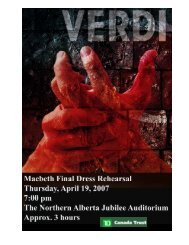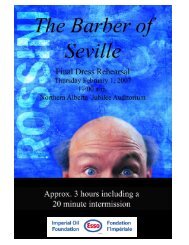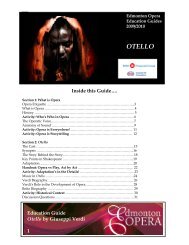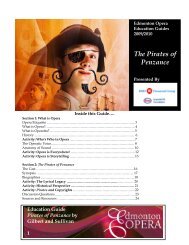Education Guide The Flying Dutchman by ... - Edmonton Opera
Education Guide The Flying Dutchman by ... - Edmonton Opera
Education Guide The Flying Dutchman by ... - Edmonton Opera
Create successful ePaper yourself
Turn your PDF publications into a flip-book with our unique Google optimized e-Paper software.
What is Expressionism?<br />
Generally speaking, “Expressionist” refers to art that<br />
portrays extreme emotion. Although there is no<br />
particular “School of Expressionism,” the term is most<br />
frequently used in relation to German artists of the late<br />
19 th and early 20 th century, whose art focuses on an<br />
“inner vision” rather than realistic portrayal.<br />
Expressionism was a revolt against naturalism and<br />
Expressionist artists like Edward Munsch created art<br />
that focused not on realistic portrayal, but a visual<br />
expression of emotions.<br />
What is German Expressionist<br />
Cinema?<br />
Expressionist Cinema in Germany was a kind of art-film<br />
(as opposed to Hollywood films of the same era) that<br />
echoed Expressionist art. <strong>The</strong> Expressionist films<br />
“<strong>The</strong> Scream” <strong>by</strong> Edward Munsch (1893) is a<br />
hallmark work of Expressionism.<br />
Image from http://en.wikipedia.org/wiki/Expressionism<br />
created in Germany from 1913 until about 1930 (also sometimes called Weimar Cinema, after<br />
the Weimar Republic that governed Germany before the rise of Nationalist Socialism) are<br />
distinguished <strong>by</strong> the extraordinary and skewed dimensions of the sets, the thick, frozen makeup<br />
of the performers, and the low lighting.<br />
Two of the most well-known films from this period are Nosferatu<br />
(1922) and <strong>The</strong> Cabinet of Dr. Caligari (1919). While it is debatable if<br />
Nosferatu actually qualifies as an Expressionist work, the film<br />
certainly encapsulates the feeling of terror (and is known for singlehandedly<br />
introducing “vampires can be killed <strong>by</strong> sunlight” into the<br />
vampire oeuvre). <strong>The</strong> Cabinet of Dr. Caligari makes extensive use of<br />
extreme angles and altered spatial relationships to portray visually<br />
the emotional and psychological extremes experienced <strong>by</strong> the<br />
characters. <strong>The</strong> angles and lighting of Weimar Cinema were<br />
influential in the development of film (especially the horror genre)<br />
in America, in part because so many film makers left Germany for<br />
Hollywood before the Nazis came to power in 1936.<br />
A still from <strong>The</strong> Cabinet of Dr. Caligari.<br />
Image from Encyclopedia Britannica Online<br />
<strong>Education</strong> <strong>Guide</strong><br />
<strong>The</strong> <strong>Flying</strong> <strong>Dutchman</strong><br />
<strong>by</strong> Richard Wagner<br />
21
















